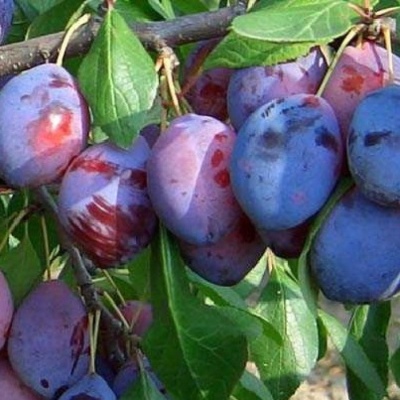
- Authors: V.P. Yagunov (Suzdal variety section)
- Name synonyms: Prunus domestica Dashenka
- Growth type: medium-sized
- Crown: pyramidal, medium density
- Tree height, m: 3
- Fruit size: large
- Fruit weight, g: 40-50
- Fruit shape: elongated oval
- Fruit color: pink-red with bluish-gray waxy bloom
- Skin : thin
Plum Dashenka is a popular variety among gardeners, which is appreciated for its ability to grow in harsh climatic conditions and delicious fruits. High yield, resistance to frost and pests are the key advantages of the crop.
Breeding history
The variety was bred by the domestic breeder V. Yagunov, who named the plum in honor of his own granddaughter. Another official name of the variety (official) - "Hungarian".
Description of the variety
Dasha is a tree of medium height.
Specifications:
- height - 3 meters;
- the leaves are of medium size and rich green color, they are glossy and oval;
- the bark is dense, gray in color;
- the shape of the shoots is arched.
The plant is suitable for growing in conditions of low temperatures and droughts. For these properties, the plum is liked by gardeners of the northern regions.
Fruit characteristics
The variety forms oval plums weighing up to 50 g. Fruit characteristics:
- thin peel of a pinkish-red hue;
- large size and elongated oval shape;
- clear abdominal seam;
- tender pulp;
- medium oval bone, which does not separate well from the pulp.
Features of the variety - a slight bluish coating of the peel and the presence of small dark subcutaneous dots.
Taste qualities
Tasters rate the taste of the plum as sweet and sour. The fruits can be eaten fresh, and plums are also suitable for conservation. Delicious jam, jam, adjika and other preparations are made from them.
The fruits are rich in nutrients and trace elements that are involved in the renewal and formation of bones, improve the functioning of the nervous system, and also have other positive effects on the body. When ripe, plums attract with a rich aroma.
Ripening and fruiting
Dasha begins to bear fruit only 3-5 years after planting. The first flowers appear closer to May, the fruits ripen in early autumn. Harvesting is already possible in September.

Yield
The variety has a high yield, for which it is appreciated by gardeners. On average, it is possible to collect up to 50 kg from a tree per season. The transportability of the fruit is good, despite the thin skin. The long shelf life enables the drains to be transported over long distances.
Self-fertility and the need for pollinators
The plum is partially self-fertile, therefore it requires planting pollinating trees near itself.
Growing and care
The correct approach to planting and growing crops will help to achieve a good harvest. You need to start by choosing a place.Plum is quite demanding, the main recommendations will be as follows:
- the site should be sunny and practically windless, however, light partial shade is acceptable;
- groundwater should lie at such a depth that the plant does not rot from excess and does not dry out from lack of moisture;
- black soil, loamy and sandy loam soils are suitable for planting;
- the soil cannot have an overestimated acidity indicator;
- it is better to plant a plum on flat areas where the plant will quickly take root.
Before planting, it is recommended to pre-dig up the ground, apply fertilizers from organic compounds and loosen the soil to saturate it with oxygen. It is better to plant seedlings in the spring, when the weather is warm. At the end of planting, 10 liters of water are added to the soil.
Young seedlings are in great need of care: timely watering and fertilization, pruning.
- Within 3 years from the moment of planting, the plant must timely receive the required volume of water in the amount of 20 liters. It is recommended to water the plum 2 times a week. The liquid must be defended before use.
- The plant does not need to be fed for 2 years while it is forming. Further fertilizing is recommended before flowering and in autumn, but after harvest. Mineral and nitrogen compositions are used as fertilizers.
- Pruning. The first procedure is carried out at the time of planting to form the crown. Further, pruning must be performed twice per season: in spring and autumn, removing all shoots, except for the main ones, and also shortening branches that are too long.
Taking into account the recommendations will allow you to achieve stable fruiting.




Disease and pest resistance
Despite its good immunity to most pests and diseases, the plum is attacked by aphids, which destroy flowers and leaves. The fight against harmful insects involves preventive treatments, as well as manual cleaning of pests from damaged leaves.
Among the diseases for plums, clasterosporia is dangerous - a fungus that kills leaves and shoots. Irrigation with a solution containing copper sulfate and regular loosening of the soil will help to strengthen the plant's immunity.

Despite the fact that plum is considered more hardy than many fruit trees, it is not immune from diseases. It is attacked by viral, fungal and bacterial infections, and parasitic insects harm it. It is necessary to notice and recognize the signs of plum disease in time. They are easier to deal with and defeat early on. Well, in order to protect the garden tree from such a misfortune in the future, preventive procedures can be carried out.



































































